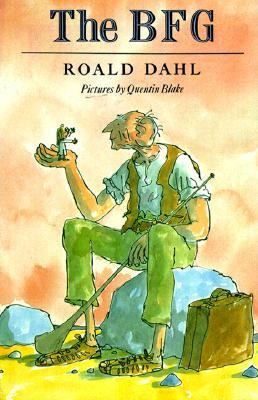Market Basket and the BFG
When I was food shopping I met an unusual cashier. Read my description of her below.
I see her as I steer my cart toward her register . . .
Standing before me is a Quentin Blake caricature sprung from Roald Dahl’s mind. Atop her head, a dusty wig clings like a sickly rodent. The breadth of her shoulders must require her to pass sideways through doors. Without greeting me, she begins scanning my items and batting them down the belt. BOINK! BOFF! As my bananas bounce by, she pins me with a glare to indicate that she has finished. I hand her my card. When she returns it with the receipt I smile and venture a “thank you.” The cashier pauses, taking my measure, and then gives a guttural response that does not involve lip movement. Maybe I have cheered her with my courtesy and perhaps she feel bad about her grumpiness, because as I wheel away she tosses me one friendly tidbit–she does not tell me to have a great day.
Part I
Show Not Tell
1. What word would you use to describe how this cashier is feeling?
2. What three things does the cashier do to show this?
Roald Dahl is an expert at showing his characters’ moods. Read the passage below from Matilda.
“Shut up,” the father said. “Stop guessing and trying to be clever.” . . . The father’s face was beginning to go dark red. “You . . . you little cheat!” the father suddenly shouted, pointing at her with his finger. “You looked at my bit of paper!”
3. How is Mathilda’s father feeling?
4. Draw a picture of how you imagine her father.
5. What are two things the father says to show his feelings?
6. What are two things the father does to show his mood?
7. Now it’s your turn to play Show Not Tell. Look at the pictures below and imagine how each person or animal is feeling. What word would you use to describe each character’s mood.
8. Choose one picture and write a description of three or more sentences that shows how your character is feeling. Include what your character is doing and saying.
Part II
It’s Like . . .
9. Do you think the cashier had a beautiful wig on? How do you know this?
10. Draw a picture of the cashier with her wig on.
To help readers see the cashier’s wig, I compared it to a sickly rodent clinging to her head. Comparing two different things using the words “like” or “as” is using a simile. Similes are another way for writers to paint pictures for their readers. There are lots of similes in Mathilda. Here’s one describing Miss Trunchbull.
“Below the knees her calves stood out like grapefruits inside her stockings.”
11. What is the simile here?
12. What does this tell you about the size of her calves?
13. Here’s another passage from Mathilda using a simile. Miss Trunchbull is speaking.
“I want those filthy pigtails off before you come back to school tomorrow!” she barked. “You look like a rat with a tail coming out of its head!”
14. What is the simile here?
15. Draw a picture of what Miss Trunchbull thinks the girl looks like.
16. Now write your own simile to describe how one of these animals looks.

Similes can also describe actions. Here’s a section from Mathilda that uses a simile to describe Bruce Bogtrotter reacting to Miss Trunchbull.
“He was watching the Headmistress with an exceedingly wary eye and he kept edging farther and farther away from her with little shuffles of his feet, rather as a rat might edge away from a terrier . . .”
17. What is the simile here? (Remember a simile compares two things using “like” or “as.”)
18. How do you think Bruce Bogtrotter feels?
19. Now write a simile to describe one of the animal’s actions. 
The cashier in my description is batting the food down the belt. I could have used another verb that means the same thing–a synonym.
20. Look up synonyms for the verb “bat” and write down three of them.
21. Now choose one of these synonyms and rewrite my sentence using this verb.
22. The cashier gave a guttural reply when I thanked her. Write down three synonyms for the adjective “guttural.”
23. Rewrite my sentence about the cashier using one of your synonyms for this adjective.
Part IV
Creating Your Character
24. Now it’s your turn to describe someone. Watch this person or animal carefully and take notes. Write down what your character looks like and says. Decide what your character is feeling. Draw a picture.
25. After taking your notes write a description.
After writing this rough draft revise your description.
26. Read your description and underline any sentences that are telling instead of showing how your character is feeling. (She was sad.) Rewrite these sentences by describing your character’s words and actions.
27. Read your description and underline one sentence that describes how your character looks. Now write a simile instead.
28. Circle a verb. Find three synonyms for it. Choose one that is better than the rough draft word you used. Rewrite your sentence with this verb.
29. Circle an adjective. Find three synonyms for it. Choose one that is better than the rough draft word you used. Rewrite your sentence with this adjective.
30. For fun:
Read Harriet the Spy, by Louise Fitzhugh. This book is about a girl who spies on people and describes them in her notebooks. This gets her into big trouble!
For a preview of Harriet’s descriptions: http://purple-socks.webmage.com/char.htm







September 18, 2014 at 6:24 pm
I’ve learn some excellent stuff here. Definitely value bookmarking for revisiting.
I surprise how so much attempt you put to make the sort
of fantastic informative website.
September 18, 2014 at 6:43 pm
Thank you. Glad you are enjoying reading it.